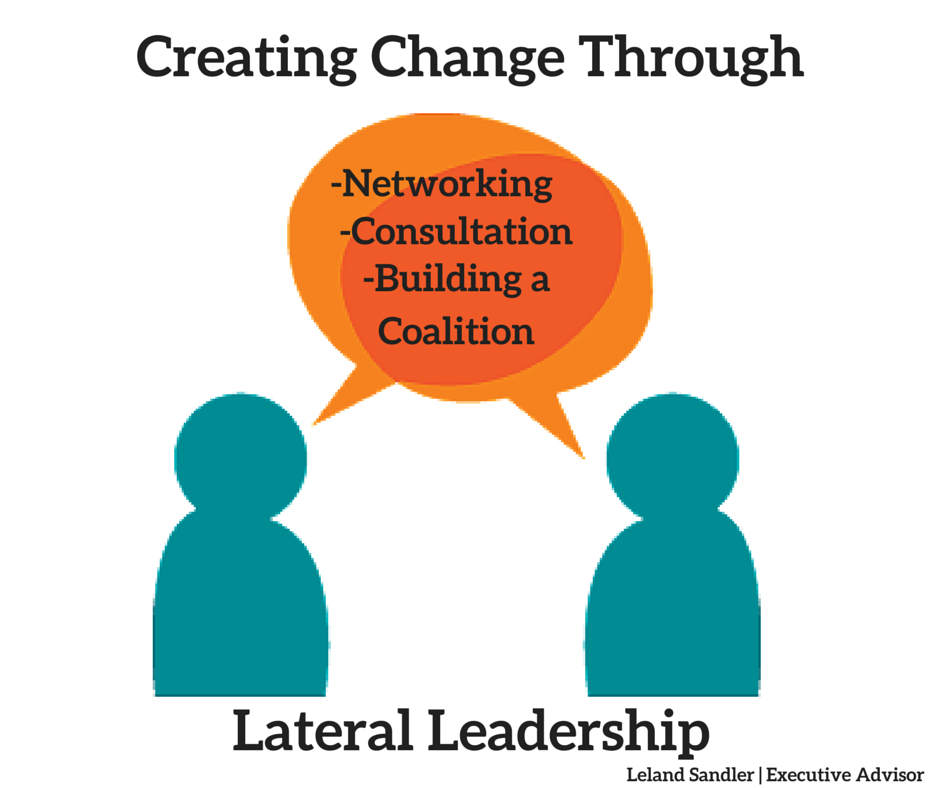by Leland Sandler | Aug 6, 2015 | Executive Advisor, Leland Sandler, The Sandler Group
 In my previous blog, I discussed several basic strategies for effectively demonstrating lateral leadership. Lateral leadership is a form of leadership where no particular title or position is required. It encourages coordination and cooperation between different groups and departments all working to achieve a common goal. You do not need to be a high level CEO or manager to be a leader. Leadership is not about waiting to be called upon to give instruction. Rather, it is about identifying the opportunities to step in and demonstrate leadership in a way that will create initiative and positive influence within the group.
In my previous blog, I discussed several basic strategies for effectively demonstrating lateral leadership. Lateral leadership is a form of leadership where no particular title or position is required. It encourages coordination and cooperation between different groups and departments all working to achieve a common goal. You do not need to be a high level CEO or manager to be a leader. Leadership is not about waiting to be called upon to give instruction. Rather, it is about identifying the opportunities to step in and demonstrate leadership in a way that will create initiative and positive influence within the group.
Honing the skills to become an effective leader takes time and patience. However, the payoff is certainly worth it. By mastering the following strategies for lateral leadership, you will soon find doors to success swinging open with endless opportunities to create valuable change for your organization.
Networking
Establishing a broad network of relationships with people both inside and outside your company and field of expertise is an essential part of becoming a lateral leader. Through networking, you will find people who are willing to offer you support and people who can provide you with connections to even bigger networks, expanding your overall capacity for success.
Consultation
Take the time to meet with your team and the people you are working with. Ask about their ideas and opinions on how to achieve the task at hand while sharing your own thoughts and ideas as well. Reacting to one another’s ideas and bouncing different ideas of each other will help you learn how the goals of the group will be completed most effectively for everyone involved. There is always more than one way to go about completing a task. Some managers will stick strictly to their own strategies that have worked in the past. However, every individual is unique and works in a different way. Instead of forcing your way on others, try engaging in more productive consultation.
Building a Coalition
Simply put, there is strength in numbers. Gathering a group of influential people together around a common goal will create a higher sense of authority and lead to higher levels of support. Building a coalition of supporters and individuals who believe in the same goal plays a vital role in lateral leadership. Instead of standing alone, find others who are going to be affected by the change you are proposing and get them on the same page. Once everybody understands and supports the big picture, each individual will take on their necessary role to lead the organization into the great and inevitable change that is sure to follow.
by Leland Sandler | Jul 29, 2015 | Executive Advisor, Leland Sandler, The Sandler Group

Demonstrating leadership does not require a specific title or rank in an organization. Whether you are a CEO, assistant manager, intern, replacement hire, new hire, or even a recent college graduate looking for a first job, it is important to be able and willing to take on a leadership role at any given point in time throughout your career. In today’s complex business world, management positions are not always clear cut. Employees may work as a team on an equal playing field or work under multiple supervisors at a time. At one point or another in your career, you may find yourself having to lead a group of people who you have no formal authority over. When this is the case, there are several techniques and principles that will lead you on the road to success. Throughout my many years as an executive advisor with the Sandler Group, I have found the following principles to be the most effective:
-
Enthusiasm
Positivity, hard work, and enthusiasm are contagious. Individuals who show genuine passion and appreciation for their work often deliver great results and motivate others to do the same. People are naturally drawn to leaders with a clear vision and high level of enthusiasm. Even when you are not directly in charge, you can always offer leadership by raising the overall energy of a group, and motivating them around one common goal. Often, pure emotion and leading by example are more effective strategies than giving orders and directives.
-
Maintain Your Ego
In order to demonstrate leadership effectively, one must do so without acting arrogant or looking for approval. When an egocentric individual does have authority over a group, the group will often complete the required tasks, but may do so begrudgingly and without optimal effort. As this is the case, an egocentric individual giving instruction to a group without formal authority will not be taken seriously. When employees don’t respect their leaders and are left uninspired, their work ethic becomes less efficient, causing their business to slowly decline. Be open to others. Recognize that you are not the one who needs to have all the answers; rather you are the one to help bring about the best answers from the group.
-
Be Invested- Ask Questions
An effective informal leader does not stand around keeping watch over other individuals. Rather, the informal leader plays an active role in the group’s efforts by being authentically inquisitive and asking questions. The ultimate goal of any leader is to ensure a certain outcome is achieved effectively by a group of individuals. How that leader goes about his efforts determines how successful the outcome will be. Being engaged in a project as a leader will have a positive influence on the others in the group, showing them you are just as invested in the project as they are. Demonstrating inspiring and authentic leadership skills will make a big difference in the success of your business as well as the success of your career.
 In my previous blog, I discussed several basic strategies for effectively demonstrating lateral leadership. Lateral leadership is a form of leadership where no particular title or position is required. It encourages coordination and cooperation between different groups and departments all working to achieve a common goal. You do not need to be a high level CEO or manager to be a leader. Leadership is not about waiting to be called upon to give instruction. Rather, it is about identifying the opportunities to step in and demonstrate leadership in a way that will create initiative and positive influence within the group.
In my previous blog, I discussed several basic strategies for effectively demonstrating lateral leadership. Lateral leadership is a form of leadership where no particular title or position is required. It encourages coordination and cooperation between different groups and departments all working to achieve a common goal. You do not need to be a high level CEO or manager to be a leader. Leadership is not about waiting to be called upon to give instruction. Rather, it is about identifying the opportunities to step in and demonstrate leadership in a way that will create initiative and positive influence within the group.

Follow Me